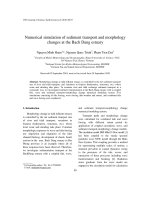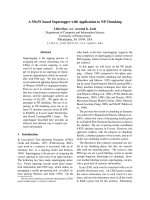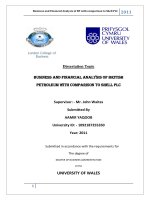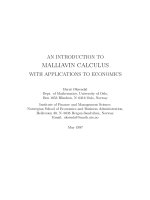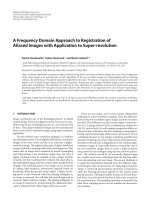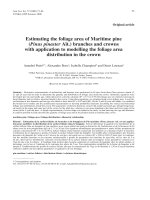Numerical simulation of interface delamination with application to IC packaging
Bạn đang xem bản rút gọn của tài liệu. Xem và tải ngay bản đầy đủ của tài liệu tại đây (3.69 MB, 132 trang )
NUMERICAL SIMULATION OF INTERFACE
DELAMINATION ⎯ WITH APPLICATION TO IC
PACKAGING
CHEONG WEE GEE
(B. Eng. (Hons.), NUS)
A THESIS SUBMITTED
FOR THE DEGREE OF MASTER OF ENGINEERING
DEPARTMENT OF MECHANICAL ENGINEERING
NATIONAL UNIVERSITY OF SINGAPORE
2004
Acknowledgements
Acknowledgements
The author would, first of all, like to express his thanks to his research supervisor,
Associate Professor Cheng Li, for her patience, guidance and moral support throughout
the course of the project. Through her enthusiasm and expertise, she has imparted much
knowledge and shared valuable insights to the research process.
The author would also like to express his gratitude to Dr Guo Tian Fu, visiting
researcher from Tsinghua University, for his invaluable guidance and assistance in the
theoretical and computational aspects of the project. His patience and willingness to
share his knowledge have been a constant help in completing the research.
The author is also grateful to Chong Chee Wei, Thong Chee Meng, Leo Chin Kin and
Chew Huck Beng, fellow postgraduate students of A/Prof. Cheng Li, for the assistance
in the clarification of ideas crucial to the project and for the constant encouragements.
Sincere gratitude also goes to the technical officers and peers in the Strength of
Materials Laboratory 2, and many others who have contributed to the completion of
this thesis.
i
Table of contents
Table of contents
ACKNOWLDEGEMENTS
i
TABLE OF CONTENTS
ii
SUMMARY
v
LIST OF FIGURES
vii
LIST OF TABLES
xii
CHAPTER 1
INTRODUCTION
1
CHAPTER 2
LITERATURE REVIEW
5
2.1
Introduction to IC packaging
2.1.1
2.1.2
2.2
Integrated circuits (IC) package
Reflow Soldering Process
Moisture Induced Failure in IC packages − Popcorn Failure
2.2.1
2.2.2
Popcorn failure of plastic encapsulated microcircuits (PEM)
Popcorn failure of plastic ball grid arrays (PBGA)
5
5
7
8
9
12
2.3
Moisture diffusion in IC packaging
14
2.4
Estimated initial void size of typical IC package materials
18
2.5
Modeling popcorn failure in IC packages
20
2.6
Moisture Sensitivity Tests
22
CHAPTER 3
COMPUTATIONAL CELLS AND NUMERICAL
IMPLEMENTATION
25
3.1
Characteristics of polymeric IC package materials
25
3.2
Mechanism-based Fracture Mechanics − Cell Element Model
26
ii
Table of contents
3.3
Modified Gurson flow potential
28
3.4
Modified Gurson flow potential incorporating coalescence effect, f *
30
3.5
Numerical Implementation
32
CHAPTER 4
VAPOR PRESSURE ASSISTED INTERFACE
DELAMINATION OF THIN QUAD FLAT PACK
34
4.1
Introduction
34
4.2
Problem Formulation
35
4.2.1
4.2.2
4.2.3
4.2.4
4.2.5
4.3
Results and Discussions − Die Pad/Molding Compound
Interface Analysis
4.3.1
4.3.2
4.3.3
4.3.4
4.3.5
4.3.6
4.3.7
4.4
Effects of Strain Hardening Exponent, N
Effects of Initial Void Volume Fraction, f0
Effects of vapor pressure
MST cycle effect
Behavior of Individual Elements along the die pad/molding compound
interface
Crack initiation and propagation along the die pad/molding
compound interface
Effects of die pad materials
Results and Discussions − Die/ Die Attach Interface Analysis
4.4.1
4.4.2
4.4.3
4.4.4
4.4.5
4.4.6
4.4.7
4.5
Material Model
Cell model application at die pad/molding compound interface
Cell model application at die attach
Moisture distribution modeling at die attach
MST Loading and Numerical Procedure
Effects of Strain Hardening Exponent, N
Effects of Initial Void Volume Fraction, f0
Effects of Initial Vapor Pressure, p0/σ0
MST cycle effect
Behavior of Individual Elements along the die/die attach interface
Crack initiation and propagation along the die/die attach interface
Effects of die pad materials
Results and Discussions − Moisture Distribution Effects at
Die/Die Attach Interface
4.5.1
4.5.2
4.5.3
Piecewise Constant Distribution
Linear Distribution
Fick’s Second Law Distribution
35
36
38
39
44
45
45
47
48
50
52
56
58
59
60
61
62
63
66
69
70
72
72
73
75
iii
Table of contents
4.6
Chapter Conclusion
CHAPTER 5
THERMO-MECHANICAL ANALYSIS OF
PLASTIC BALL GRID ARRAYS WITH
VAPOR PRESSURE EFFECTS
76
79
5.1
Introduction
79
5.2
Problem Formulation
81
5.2.1
5.2.2
5.2.3
5.2.4
5.3
Material Model
Cell Model application with coalescence effect at Die Attach
Full Field Analysis of Overmold
Moisture Sensitivity Tests and Numerical Procedure
Results and Discussion − Die Attach Analysis
5.3.1
5.3.2
5.3.3
5.3.4
5.3.5
5.3.6
5.3.7
5.3.8
5.3.9
5.3.10
Identification of critical layer in die attach
Effects of Strain Hardening Exponent, N
Effects of Initial Void Volume Fraction, f0
Effects of Initial Vapor Pressure, p0/σ0
MST cycle effect
Behavior of Individual Elements at various positions
Effects of Pb-free Reflow Soldering
Effects of Initial Vapor Pressure, p0/σ0, without f *
Crack initiation and propagation along the die/die attach interface
Interface damage with temperature dependent material property
81
84
86
86
87
88
89
91
92
94
96
99
101
103
104
5.4
Results and Discussion − Full Field Analysis of Overmold
106
5.5
Chapter Conclusion
109
CHAPTER 6
SUMMARY OF CONCLUSIONS
111
6.1
Vapor pressure assisted interface delamination and
failure of thin quad flat pack (Chapter 4)
111
6.2
Thermo-mechanical analysis of Plastic Ball Grid Arrays
with vapor pressure effects (Chapter 5)
113
REFERENCES
115
iv
Summary
Summary
The study of interface delamination of integrated circuits (IC) packages, which often
are intricate multilayer structures, forms the basis of the present research. Numerical
simulation is employed to gain a deeper understanding on the initiation of cracks in IC
packages during reflow soldering. Using the vapor pressure incorporated cell element
model, the research concentrates on identifying the possible mechanisms that cause the
initiation of interface delamination, and also the position of crack initiation along
interfaces in common IC package geometries, explicitly a thin quad flat pack (TQFP)
and a plastic ball grid array (PBGA) package. The cell element model is also used to
identify critical interfaces in an IC package that will undergo extensive damage.
For TQFP, the focus is on the die pad/molding compound interface (Type I popcorn
failure) and the die/die attach interface (Type II popcorn failure). For both interfaces,
increased initial porosity and initial vapor pressure levels cause rises in the void growth
and fall in stress carrying capacity of the cell elements, resulting in weakened interfaces.
High initial porosity and vapor pressure favor formation of a continuous damage zone
along the die/die attach interface. The regions of intense void growth for both interfaces
appear to concentrate near the interface corners. For each of the interfaces considered,
crack initiates close to the interface corner and propagates in both directions towards
the interface center and corner. Furthermore, by replacing the material of the copper die
pad with alloy42, the die/die attach interface experiences more damage while the die
pad/molding compound interface undergoes less void growth, suggesting that different
die pad materials will increase the factor of risk for different popcorn failure types in
TQFP. Since the die attach is sandwiched between two moisture impermeable
substrates and only allows moisture diffusion from the interface corner, a further
v
Summary
investigation is made by modeling the die/die attach interface with non uniform vapor
pressure levels. It is found that, even with the limited amount of moisture diffused into
the die attach, the die/die attach interface undergoes significant void damage.
A parametric study of the effects of vapor pressure and thermal mismatch stress on a
plastic ball grid array (PBGA) package is also performed. The vapor pressure
incorporated cell element model, with the additional feature of modeling the
coalescence effect, is adapted to model void damage and crack initiation at the die/die
attach interface in the PBGA. With higher initial porosity distribution and initial vapor
pressure, the integrity of the interface is largely compromised. For the analyses with
temperature independent and temperature dependent material properties, the interface
corner is identified as the most possible initiation site for interface delamination during
moisture sensitivity tests. As the initial vapor pressure increases, two competing sites of
interface crack initiation arises, which accounts for the fast and complete delamination
of the whole interface during the short period of reflow soldering. The phenomenon is
confirmed when investigating the behavior of the interface under Pb-free reflow
soldering, where the peak reflow temperature is raised further.
The final part of this thesis involves a full field analysis of the PBGA package when all
elements of the overmold are governed by the modified Gurson flow potential. It is
found that the zones of intense void growth and damage occur only at the interfaces,
and limited void growth occurs within the bulk material. In the event of the complete
delamination of the die/die attach interface, the critically damaged region in the
overmold closest to the die attach will undergo cracking, and lead to popcorn failure.
vi
List of Figures
List of Figures
Figure 2.1
Through-hole packages and surface mount packages.
6
Figure 2.2
A typical reflow soldering time-temperature profile.
8
Figure 2.3
Mechanism of popcorn failure of PEMs.
9
Figure 2.4
Types of popcorn failure modes: (a) Type I from the bottom of die
pad/molding compound interface; (b) Type II from the die/die
attach interface; (c) Type III from the top of molding compound/die
interface.
11
Figure 2.5
(a) PBGA popcorn failure mechanism. (b) PBGA popcorn failure
showing package cracking and delamination.
13
Figure 2.6
Flow chart for moisture sensitivity characterization.
24
Figure 3.1
Cell model for void growth and coalescence.
27
Figure 4.1
A simplified TQFP package.
35
Figure 4.2
Finite element mesh of Thin Quad Flat Pack (TQFP): (a) Plane view
37
of half package; (b) Close-up view of cell elements at die pad/molding
compound interface; (c) Close-up view of cell elements in die attach
(FPA model).
Figure 4.3
Piecewise Moisture Concentration Distribution.
40
Figure 4.4
Linear Moisture Concentration Distribution.
40
Figure 4.5
Fick’s Moisture Concentration Distribution.
42
Figure 4.6
Cell moisture concentration and vapor pressure configuration for
moisture penetration at X = 0.1 mm, 0.2 mm and 0.3 mm.
43
Figure 4.7
MST thermal loading profile.
45
Figure 4.8
(a) Current void volume fraction f, and (b) mean stress σm/σ0, along
the die pad/molding compound interface at the end of MST for N = 0,
0.05 and 0.10.
46
Figure 4.9
(a) Current void volume fraction f, and (b) mean stress σm/σ0, along
the die pad/molding compound interface at the end of MST for
f0 = 0.01 and 0.05.
47
vii
List of Figures
Figure 4.10 (a) Current void volume fraction f, and (b) mean stress σm/σ0, along
the die pad/molding compound interface at the end of MST for
p0/σ0 = 0.0, 0.5, 1.0 and 1.5.
49
Figure 4.11 (a) Current void volume fraction f, and (b) mean stress σm/σ0, along
the die pad/molding compound interface at each MST cycle for
p0/σ0 = 0.0.
50
Figure 4.12 (a) Current void volume fraction f, and (b) mean stress σm/σ0, along
the die pad/molding compound interface at each MST cycle for
p0/σ0 = 1.0.
51
Figure 4.13 (a) Current void volume fraction f, and (b) mean stress σm/σ0, at
X1/D=1, along the die pad/molding compound interface for
p0/σ0 = 0.0, 1.0.
53
Figure 4.14 (a) Current void volume fraction f, and (b) mean stress σm/σ0, at
X1/D=175, along the die pad/molding compound interface for
p0/σ0 = 0.0, 1.0.
54
Figure 4.15 (a) Current void volume fraction f, and (b) mean stress σm/σ0, at
X1/D=223, along the die pad/molding compound interface for
p0/σ0 = 0.0, 1.0.
55
Figure 4.16 History of crack initiation and propagation along the die pad/molding
compounding interface with f0 =0.05, p0/σ0 = 1.0 and fE =0.15.
56
Figure 4.17 Deformed configuration of the TQFP package: (a) half the package,
and (b) close up of the delamination site along the die pad/molding
compounding interface.
57
Figure 4.18 (a) Current void volume fraction f, and (b) mean stress σm/σ0, along
the die pad/molding compound interface for copper and alloy42 die
pad, with p0/σ0 = 0.0, 1.0.
58
Figure 4.19 (a) Current void volume fraction f, and (b) mean stress σm/σ0, along
60
the die/die attach interface at the end of MST for N = 0, 0.05 and 0.10.
Figure 4.20 (a) Current void volume fraction f, and (b) mean stress σm/σ0, along
the die/die attach interface at the end of MST for f0 = 0.01 and 0.05.
61
Figure 4.21 (a) Current void volume fraction f, and (b) mean stress σm/σ0, along
the die/die attach interface at the end of MST for p0/σ0 = 0.0, 0.5, 1.0
and 1.5.
63
viii
List of Figures
Figure 4.22 (a) Current void volume fraction f, and (b) mean stress σm/σ0, along
the die/die attach interface at each MST cycle for p0/σ0 = 0.0.
64
Figure 4.23 (a) Current void volume fraction f, and (b) mean stress σm/σ0, along
the die/die attach interface at each MST cycle for p0/σ0 = 1.0.
65
Figure 4.24 (a) Current void volume fraction f, and (b) mean stress σm/σ0, at
X1/D=1, along the die/die attach interface for p0/σ0 = 0.0, 1.0.
66
Figure 4.25 (a) Current void volume fraction f, and (b) mean stress σm/σ0, at
X1/D=115, along the die/die attach interface for p0/σ0 = 0.0, 1.0.
67
Figure 4.26 (a) Current void volume fraction f, and (b) mean stress σm/σ0, at
X1/D=187, along the die/die attach interface for p0/σ0 = 0.0, 1.0.
68
Figure 4.27 History of crack initiation and propagation along the die/die attach
interface with f0 = 0.05, p0/σ0 = 1.0 and fE = 0.15.
69
Figure 4.28 Deformed configuration of the TQFP package: (a) half the package,
and (b) close up of the delamination site along the die/die attach
interface.
70
Figure 4.29 (a) Current void volume fraction f, and (b) mean stress σm/σ0, along
the die/die attach interface for copper and alloy42 die pad, with
p0/σ0 = 0.0, 1.0.
71
Figure 4.30 (a) Current void volume fraction f, and (b) mean stress σm/σ0, along
the die/die attach interface for p0/σ0 with Xpiecewise = 0.1 mm, 0.2 mm
and 0.3 mm.
72
Figure 4.31 (a) Current void volume fraction f, and (b) mean stress σm/σ0, along
the die/die attach interface for p0/σ0 with Xlinear = 0.1 mm, 0.2 mm
and 0.3 mm.
74
Figure 4.32 (a) Current void volume fraction f, and (b) mean stress σm/σ0, along
the die/die attach interface for p0/σ0 with Xfick = 0.1 mm, 0.2 mm
and 0.3 mm.
75
Figure 5.1
68 I/O PBGA package.
81
Figure 5.2
Finite element mesh: (a) Half of PBGA package is modeled
(X1 ≥ 0); (b) Close-up of voided cell elements in the die attach;
(c) Full field analysis of overmold.
84
Figure 5.3
X-ray micrograph of die attach voids in PBGA package.
85
ix
List of Figures
Figure 5.4
Thermal Loading Profile of moisture sensitivity test (MST) with
reflow temperature at 235 oC.
86
Figure 5.5
(a) Current void volume fraction f, and (b) mean stress σm/σ0, along
the top, middle and bottom layer in the die attach at the end of MST.
88
Figure 5.6
(a) Current void volume fraction f, and (b) mean stress σm/σ0, along
90
the die/die attach interface at the end of MST for N = 0, 0.05 and 0.10.
Figure 5.7
(a) Current void volume fraction f, and (b) mean stress σm/σ0, along
the die/die attach interface at the end of MST for f0 = 0.01 and 0.05.
Figure 5.8
(a) Current void volume fraction f, and (b) mean stress σm/σ0, along
92
the die/die attach interface at the end of MST at various levels of p0/σ0.
Figure 5.9
(a) Current void volume fraction f, and (b) mean stress σm/σ0, along
the die/die attach interface at the end of each MST cycle with
p0/σ0 = 0.0.
94
Figure 5.10 (a) Current void volume fraction f, and (b) mean stress σm/σ0, along
the die/die attach interface at the end of each MST cycle with
p0/σ0 = 1.5.
95
Figure 5.11 (a) Current void volume fraction f, and (b) mean stress σm/σ0, at
X1/D=1, along the die/die attach interface for p0/σ0 = 0.0, 1.5.
97
Figure 5.12 (a) Current void volume fraction f, and (b) mean stress σm/σ0, at
X1/D=80, along the die/die attach interface for p0/σ0 = 0.0, 1.5.
98
Figure 5.13 (a) Current void volume fraction f, and (b) mean stress σm/σ0, at
X1/D=156, along the die/die attach interface for p0/σ0 = 0.0, 1.5.
99
91
Figure 5.14 (a) Current void volume fraction f, and (c) mean stress σm/σ0, along
the die/die attach interface at the end of MST at various levels of
p0/σ0, with Pb-free reflow temperature at 260oC.
100
Figure 5.15 (a) Current void volume fraction f, and (b) mean stress σm/σ0, along
the die/die attach interface at the end of MST at various levels of
p0/σ0, without f *.
102
Figure 5.16 History of crack initiation and propagation along the die/die attach
interface with f0 =0.05, p0/σ0 = 1.0 and fC = 0.15.
103
Figure 5.17 Deformed configuration of the PBGA package: (a) half the package,
and (b) close up of the delamination site along the die/die attach
interface.
104
x
List of Figures
Figure 5.18 (a) Current void volume fraction f, and (b) mean stress σm, along
the die/die attach interface at the end of MST at varying vapor
pressures, p0, with temperature dependent material properties.
105
Figure 5.19 Full field analysis: contour plots of void volume fraction f at the
end of 3rd MST cycle for (a) p0/σ0 = 0.5, (b) p0/σ0 = 1.0 and
(c) p0/σ0 = 1.5, with f0 = 0.05 and temperature independent material
properties with Treflow = 235 oC.
107
Figure 5.20 Full field analysis: contour plots of mean stress σm/σ0 at the end
of 3rd MST cycle for (a) p0/σ0 = 0.5, (b) p0/σ0 = 1.0 and
(c) p0/σ0 = 1.5, with f0 = 0.05 and temperature independent material
properties with Treflow = 235 oC.
108
xi
List of Tables
List of Tables
Table 2.1
Initial void volume fraction for some materials in IC packages.
20
Table 2.2
Moisture Sensitivity levels.
23
Table 4.1
Material properties of TQFP components.
36
Table 4.2
Table of the Error Function.
42
Table 4.3
Cell element initial vapor pressure for moisture penetration at
X=0.1 mm.
43
Table 4.4
Cell element initial vapor pressure for moisture penetration at
X=0.2 mm.
43
Table 4.5
Cell element initial vapor pressure for moisture penetration at
X=0.3 mm.
44
Table 5.1
Material properties of PBGA components.
83
xii
Chapter 1
Introduction
Chapter 1
Introduction
Driven by the ongoing trend of miniaturization and function integration, the electronics
industry requires increased power dissipation, junction temperature, and reliability
requirements on electronic packages. Packaging engineers and analysts need to
understand the important physical locations in the package where delamination will
pose real risks to package reliability. The ability to fully and accurately qualify the
materials and interface performance will be necessary for future development.
To completely understand and to characterize the basic failure mechanisms is the key in
strengthening interfaces whether they are between metal/polymer or polymer/polymer
in the assembled packages. Fundamental work will be needed to characterize material
behavior due to environment factors such as temperature and moisture as well as
interface physical characteristics such as void composition and filler content. As such,
modeling and simulation capabilities that account for the complex interface geometries
(sharp corners and voids) and the realistic materials behavior are needed. The ultimate
goal would be to simulate and optimize the design of a virtual product and also the
manufacturing process entirely based on numerical analysis before a physical product is
built.
Moisture-induced failure continues to be a major package reliability issue for plastic
integrated circuits (IC) packages. Due to the hygroscopic nature of the polymeric
Page 1
Chapter 1
Introduction
package materials, the plastic packages tend to absorb moisture during storage, causing
them to be susceptible to moisture-induced delamination and package cracking.
Confirmed by studies of moisture diffusion in various IC package types [Shook and
Sastry, 1997; Wong et al., 1998; Liu et al., 2002], the absorbed moisture condenses in
micropores and defects that are present in the substrate, solder mask, die attach and
other package materials, and along interfaces, particularly at the die pad/molding
compound and die/die attach interfaces. In dealing with popcorn failure in IC packages,
it is crucial to understand the entire cracking process: crack initiation, crack growth and
final fracture. The very question of dependence of growth of micro voids on stress,
temperature and moisture-induced conditions are of paramount practical importance.
High thermal mismatch stresses are often generated within the IC package, which
primarily consists of multilayered thin films with different coefficients of thermal
expansion. Furthermore, the absorbed moisture vaporizes rapidly during reflow
soldering, causing high internal vapor pressure within the micropores. The pressure
generated can reach 3-6 MPa [Liu and Mei, 1995], which is comparable to the yield
strengths of the overmold and die attach near glass transition temperatures. The voids,
especially those along the interfaces, are thus triggered to grow and further coalescence
at an alarming rate to cause interface delamination. Moisture in the surrounding
subsequently diffuses into the delaminated interface, adding on to the vapor pressure on
the crack surface, and increasing the crack size, ultimately leading to popcorn failure.
Vapor pressure effects on void growth in hygroscopic polymeric materials have been
studied by Guo and Cheng (2002). They showed that high porosity and high moisture
Page 2
Chapter 1
Introduction
content are exceedingly detrimental to fracture toughness. In fact, popcorn cracking
could be treated as unstable growth of a voided cell when the combined thermal loading
and vapor pressure reach the critical traction or intrinsic cavitation stress.
The above studies affirm evidence of vapor pressure assisted void growth and
coalescence as a key mechanism of popcorn failure. In Chapter 4, the combined effect
of thermal mismatch stress and internal vapor pressure on a thin quad flat pack (TQFP)
while undergoing the moisture sensitivity test (MST) is investigated. A mechanism
based approach, the vapor pressure incorporated cell element model is adapted to
model damage and predict the onset of delamination at critical interfaces, namely the
die pad/molding compound interface (Type I popcorn failure) and the die/die attach
interface (Type II popcorn failure). Each interface is modeled by a narrow strip of
porous material of initial thickness D. The exceedingly detrimental combination of
thermal mismatch stress and vapor pressure to the interfaces is studied. The effects of
different die pad materials on damage across the interfaces are also discussed. Other
factors, such as strain hardening exponent, initial void volume fraction, the progress of
each moisture sensitivity tests loading cycle, individual cell element behaviors, crack
initiation and propagation along the interfaces are detailed. A study is also made
involving the modeling of the die/die attach interface with non uniform vapor pressure
levels.
A parametric study on the effects of vapor pressure and thermal mismatch stress on a
plastic ball grid array (PBGA) package is performed. The cell element model, without
assuming any pre-existing crack, is adapted to model void damage and crack initiation,
Page 3
Chapter 1
Introduction
a precursor to interface delamination and popcorn failure, at the die/die attach interface
in the PBGA. The key difference with the analysis of TQFP lies in the additional
modeling of the coalescence effect through the complete loss of material stress carrying
capacity at a realistic void volume fraction. The effects of porosity distribution and void
vapor pressure on the integrity of the interface are discussed. The model is also
extended to consider the effects of Pb-free reflow soldering. Interface damage analysis
of the die/die attach interface using temperature dependent material properties is further
discussed. A full field analysis is subsequently performed by implementing the Gurson
constitutive law throughout the polymeric overmold to predict the likely popcorn
failure mode from identifying the severely damaged regions within the package.
The main purpose of the current thesis is to numerically simulate interface delamination
of typical IC packages described above and gain insights into the possible mechanisms
of popcorn failure. The background literature and methodology are reviewed
respectively in Chapter 2 and Chapter 3. The report concludes with a summary of all
the important findings. Where possible, relevance will be drawn between the results
from the present investigations and the documented literature to ensure consistency and
relevance, and the implications of the findings will be discussed.
Page 4
Chapter 2
Literature Review
Chapter 2
Literature Review
2.1
Introduction to IC packaging
2.1.1
Integrated circuits (IC) package
An IC package is utilized to protect, power and cool microelectronic devices or
integrated circuits and to provide electrical and mechanical connection between the
device and the outside world. Different packaging process is used for different chips,
and many types of IC package technologies have been developed that vary in their
structures, materials, fabrication methodology, bonding technologies, size, thickness,
number of input-output (I/O) connections, heat removal capability, electrical
performances, reliability and costs [Morris and Tummala, 2001].
IC packages can be classified generally into two categories: through-hole and surface
mount. The two categories refer to the methodology used in assembling the packages to
the printed wiring board (PWB). Through-hole packages have pins that can be inserted
into holes in the PWB. Surface mount packages, on the other hand, are not inserted into
the PWB, but are mounted on the surface of the PWB. The advantage of the surface
mount package, as compared to the through-hole, is that both sides of the PWB can be
used, and therefore allows higher packing density on the board.
Figure 2.1 shows the two categories of packages. Dual-in-line packages (DIP) and pin
grid arrays (PGA) are through-hole packages. In DIPs, the I/Os, or the pins, are
Page 5
Chapter 2
Literature Review
distributed along the sides of the package. To achieve higher I/O connections, PGAs
are used where the pins are distributed in an area array fashion underneath the package
surface. Most of the advances in package design and performance are observed for
surface mount packages. The small outline (SOP) package is the most widely used
package in modern memory for low I/O applications because of its extremely low cost.
The quad flat package (QFP) is an extension of the SOP with larger I/O connections.
Both the SOP and QFP have leads that can be attached to the PWB. There are also
leadless packages such as leadless chip carrier (LCC) and plastic leader chip carrier
(PLCC), but their usage is very limited.
Figure 2.1 Through-hole packages and surface mount packages [Morris and
Tummala, 2001].
Packages with solder balls were later developed as an alternative to packages with leads.
One example is the ball grid array (BGA) packages. The solder balls can be placed
underneath the surface of the package in an area array and significantly increase the I/O
Page 6
Chapter 2
Literature Review
count of surface mount packages. During assembly, surface mount packages are placed
on pads patterned on the printed wiring board and pretreated with solder paste. The
board is then heated, during which the molten solder paste reflows around the leads,
simultaneously forming electrical and mechanical connections.
Smaller, thinner and lighter packages are required in the modern age of portable and
hand-held products. Chip scale package (CSP), which is a package whose area is less
than 1.2 times the area of the normal IC packages, have been developed to address
these demands of modern electronics. To package the various types of ICs and provide
high performance and low-cost solutions is a challenging task for package engineers.
2.1.2
Reflow Soldering Process
Reflow soldering, commonly used in assembling surface mount devices, involves
remelting (reflowing) solder previously applied to a PWB joint site (pad) in the form of
a preform or paste. No solder is added during reflow [Gallo and Munamarty, 1995]. A
typical reflow temperature profile involves preheat, dryout, reflow and cooling, as
shown in Fig. 2.2. In the preheat zone, the temperature of the assembly is raised to
100oC to 150oC at a rate low enough, usually 2oC/sec, to prevent solvent boiling and
the formation of solder balls.
The second stage is the slow heat/dry zone, where the temperature is increased to the
solder melting point, activating the flux in the solder paste. The activated flux removes
oxides and contaminants from the surfaces of the metals to be joined. The heating is
kept short to allow the moisture in the paste to evaporate without splattering the solder.
Page 7
Chapter 2
Literature Review
At the third stage, the temperature of the assembly is raised to about 220oC to 260oC
(the melting point of the solder is 183oC). The total time that the solder is above the
melting point, or wetting time, is normally 30 to 60 seconds, and is critical to reliable
solder joint formation. It is during the wetting time that the solder paste melts and
reflows to form the solder joint.
Figure 2.2 A typical reflow soldering time-temperature profile [Pecht, 1999].
2.2
Moisture Induced Failure in IC packages − Popcorn Failure
IC package materials are hygroscopic in nature, i.e. they absorb moisture readily.
Popcorn failure is caused by the damaging effects of moisture, which is absorbed due to
the storage of plastic IC packages in a noncontrolled humidity environment. The
popcorn mechanism for two kinds of IC packages, plastic encapsulated microcircuits
(PEM) and plastic ball grid arrays (PBGA), are discussed.
Page 8
Chapter 2
2.2.1
Literature Review
Popcorn failure of plastic encapsulated microcircuits (PEM)
The popcorn failure mechanism of plastic encapsulated microcircuits is showed in Fig.
2.3. When moisture, present in the factory environment, is absorbed through the
package exterior, it condenses in micropores and defects in the molding compound and
die attach materials, and along interfaces, particularly in the die pad/molding compound,
die attach/die pad and die /die attach interfaces.
Figure 2.3
Mechanism of popcorn failure of PEMs [Gallo and Munamarty, 1995].
As the PEMs are heated to reflow temperature, thermomechanical and moisture
induced stresses are developed. The stresses are caused by:
•
rapid vaporizing of absorbed moisture, resulting in steam and build-up of vapor
pressure;
Page 9
Chapter 2
•
Literature Review
coefficient of thermal expansion mismatch between the various PEM components
causing mismatch stress at elevated temperatures;
•
decrease in the strength of the PEM polymeric components, such as molding
compound and die attach, near the glass transition temperature;
•
expansion of molding compounds after absorbing moisture; consequently molding
compounds in a moisture saturated package experience approximately 20% more
hygrothermal strain when exposed to reflow heating than a dry package [Ngyuyen
et al., 1995].
Vaporizing moisture increases the vapor pressure in the delaminated cavity. If the
hygrothermal stresses and vapor pressure exceed the adhesion strength and fracture
toughness of the molding compound, they become the driving force behind the
delamination growth and crack formation. As a result, a crack forms that may
propagate laterally outwards. When the crack reaches the package exterior, high
pressure water vapor is suddenly released producing an audible popping sound.
Currently, the most reliable solutions in preventing such package cracking have been
dry-packing the packages prior to shipping, or baking them before board mounting, but
such solutions add costs and time to the manufacturing throughout. To bypass such an
approach, extensive work has been done to understand and find alternate solutions,
especially on improving the crack resistance of the molding compound. However, with
the introduction of more crack-resistant molding compounds, recent studies have
indicated the fracture mechanism is tending to shift, from the common delamination at
Page 10
Chapter 2
Literature Review
the die pad/molding compound interface to the interfaces in the die attach, complicating
the problem further. [Fukazawa et al., 1985; Chen et al., 1994]
(a)
(b)
(c)
Figure 2.4 Types of popcorn failure modes:
(a) Type I from the bottom of die pad/molding compound
interface [Dudek et al., 1998];
(b) Type II from the die/die attach interface [Dudek et al., 1998];
(c) Type III from the top of molding compound/die interface [Chai
et al., 1999].
Page 11
Chapter 2
Literature Review
There are generally three types of popcorn failure modes [Omi et al., 1991] that can be
identified in relation to the delaminated interfaces in PEMs. Type I refers to cracking
from the bottom of die pad/molding compound interface delamination, type II from the
die/die attach interface delamination, and type III from the top of die/molding
compound delamination (Figure 2.4).
Another effect of moisture in popcorn cracking, other than the increase in stress due to
moisture vaporizing in the delaminated interface, is that it degrades the adhesion
between the die pad and the molding compound [Tay and Lin, 1996a; Tanaka and
Nishimura, 1995]. It has been found by Tay et al. (1994) that, through measuring the
adhesion strength of the die pad/molding compound interface for various levels of
moisture preconditioning, the greater the level of moisture, the lower the adhesion
strength of the interface. Thus, confirming that moisture degrades the adhesion between
the die pad and molding compound.
2.2.2
Popcorn failure of plastic ball grid arrays (PBGA)
In recent years, plastic ball grid arrays have gained in popularity because of their ability
to provide increased I/O density, high electrical performance and ease of circuit card
assembly [Pecht, 1999]. However, one drawback to PBGA packages is their moisture
absorbing characteristics. The most common failure mode in the PBGA packages
occurs in the die attach region during solder reflow [Yip et al., 1996]. Similar to PEMs,
moisture is absorbed from the surroundings, and condenses in micropores and defects
that are present in the substrate, solder mask, die attach materials, and along the
interfaces in the die attach. During reflow, condensed moisture vaporizes, creating an
Page 12

